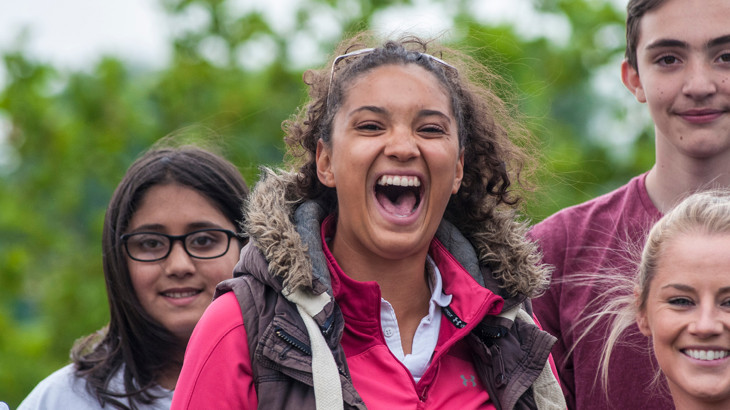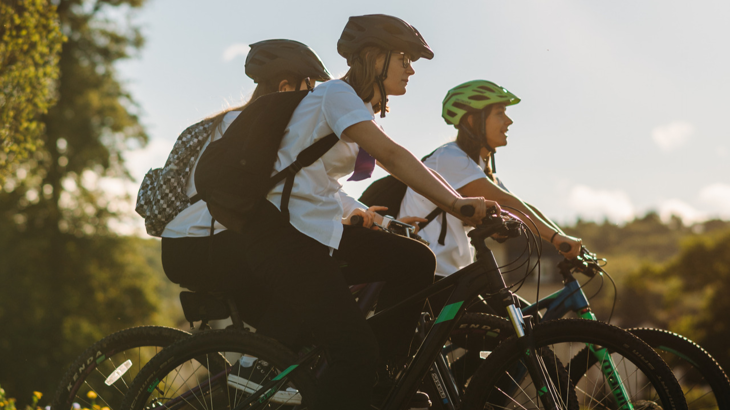Discover the fascinating interplay between biology and behaviour change in teenagers when it comes to cycling participation. In our latest blog, Behaviour Change Officer, Sylvia Gauthereau delves into the intricate workings of the teenage brain and the impact of puberty, shedding light on why teenagers exhibit certain behaviours and how we can effectively engage them in cycling initiatives.

Adolescence serves as a critical period for the brain to explore and experience a wide range of activities. Credit: Michael Kelly
Understanding teenage brain development and its implications for cycling projects
The brain develops slowly, with myelin gradually connecting different areas.
This myelination starts at the back of the skull and takes years to reach the decision-making centre of the brain.
Until then, the emotional centre dominates because communication between brain areas is slower.
That’s why, when planning cycling projects, it's important to remember that teenagers' brains are still developing and influenced by emotions.
Here and now is the best it will ever feel
Teenagers are often labeled as risk-takers. However, this perception only tells part of the story.
Teenagers are biologically wired to seek thrills and excitement.
But recent research reveals that when alone, their risk-taking behaviour is similar to that of adults.
However, it all changes when they know they are being watched by their peers.
At that stage, the emotion centre is better wired and more active, that’s why an adult can't naturally match the intensity of a thrill experienced as a teen.
This is something we have witnessed at Sustrans during our on-road cycling training sessions.
Feedback almost always includes: “Loved cycling down the hill!”, and there is always someone having a go at cycling with their hands high in the air, especially when there is an audience of their peers present.
That’s why, when delivering cycle training, we need to keep in mind that teenagers will respond better to activities that engage their senses, rather than relying solely on their rational thinking.

Teenagers feel the urge to fit in within their peer group. Credit: Chandra Prasad
The brain's capacity for change during adolescence
During adolescence, the brain is highly active, with all areas in a state of intense activity, even though they are not yet fully connected.
Because of this heightened brain activity, teenagers have a high capacity for change.
Adolescence serves as a critical period for the brain to explore and experience a wide range of activities, as it triggers a process of brain cleanup.
Brain development follows the ‘use it or lose it’ model, whereby pathways not used are gradually switched off and the brain starts specialising to function more efficiently.
This is a fundamental stage of our development and a time when the brain has a particular ability to learn new skills.
It's important to note that a brain cannot sustain constant activation and communication among all neurons; it naturally undergoes a maturation process.
Engaging in new activities, particularly those with rewarding outcomes, triggers pleasurable sensations, which is evolutionarily wired to encourage exploration beyond familiar boundaries.
This provides a great opportunity to create lifelong habits, like cycling, with benefits that will last a lifetime.
Understanding teenage brain development and the impact of puberty
Alongside everything else, the teenage years are also a time when we go through puberty, which brings significant changes to the mind, the brain, and the body.
For medical and biological reasons, puberty aligns with our innate desire to explore the world further afield, beyond our family circle and gene pool.
This means pulling away from our immediate familiar circle and rejecting the world which sees us through the lens of forgiveness and unconditional love.
An urge to fit in within our peer group and a need to be acknowledged and rewarded for what we do ensues.
Sometimes, this can be misconstructed as a lack of empathy or bored indifference, but the limited lived experience, combined with the not fully developed ability to think rationally yet, makes this journey particularly challenging.
The feeling of being judged and misunderstood is overwhelming and domineering.

Cycling provides teenagers with a sense of independence and freedom. Credit: Kevin J Thomson
A developing human brain
The brain is a beautifully complex organ that takes its time to slowly develop even after birth.
The human brain is scientifically defined as adult around our mid-20s.
Whilst we are all born with grey matter (neurons), it is the white matter (myelin) that connects it all.
The wrapping of the brain with myelin starts at the back of the skull and takes years to reach the prefrontal cortex, which is the decision-making centre.
Until then, the brain remains dominated by the emotion centre (amygdala) because communication is slower between the different areas of the brain.
That’s where teenagers are at, and we need to remember that when delivering cycling projects.

When delivering cycling projects to teens, we need to remember that their brain is dominated by the emotion centre. Credit: Neil Hanna
Tailoring cycling programs to the needs of different teenage participants
A group training session will yield a very different behaviour from a one-to-one session.
But also, a group dynamic will also change from one group to the next.
It is crucial to acknowledge this fact because adolescence is a time of constant turmoil for a teenager's sense of self, so any validation, rejection, or indifference from their peers can significantly impact their willingness to engage in the sessions.
Each new generation of adults tends to forget that they too were a teen once, but thanks to progress in neuroscience we can now see what happens in the brain during the transition between childhood to adulthood.
Most of this process is out of teenagers’ control and our expectations when drafting lessons and planning activities should consider biology.
This highlights the need to tailor cycle skills sessions to each group and invest time in getting to know the group and adapt accordingly.
Things to remember when delivering cycle lessons:
- Teenagers respond to immediate thrills, emotions, and new experiences, influenced by how they are perceived by their peers.
- They have a sense of right and wrong but may not fully rationalize potential dangers yet.
- Encourage their exploration and praise their initiative, even if they have "bad cycling habits."
Ask them about their feelings regarding cycling and learning new skills, supporting them based on their desires. - Don't take things personally; teenagers use coping mechanisms to fit in, and our reactions guide them.
- Relate to their experiences: passion, excitement, longing for change; be genuine in connecting with them.
- Publicly praise and offer suggestions privately, respecting their desire to avoid standing out.
Acknowledge our shared vulnerabilities and desires for extraordinary moments.
Our physical environment is rarely suited to teenagers
In groups, teenagers are seen as an inconvenience, let alone cycling in groups.
While there are some amenities for younger children (playgrounds, play streets), teenage spaces remain limited.
In the meantime, society provides plenty of easy ways to get dopamine bursts nowadays (i.e. social media), potentially leading to mental health issues and abuse.
Acknowledging that the world - which includes the built environment - is not made for them, is not a requirement that teenagers have to change to adapt but something they can relate to and anchor onto.
Learning to cycle and identifying where the environment fails them will give them the confidence to demand better.
Young people are able to positively impact society beyond their age group and beyond their generation if they are given more agency.
It gives voice to those who also have a stake in the built environment but whose voices are rarely heard by those with the power to change it.
After all, two out of five humans are teens.
Encouraging cycling for all
At Sustrans, part of our work is to encourage and increase cycling participation to under-represented groups, especially those who do not engage or are less likely to cycle.
For all the reasons explained above, we know that cycling aligns particularly well with the teenage thirst to explore farther, independently from family and to be with their peers.
And yet, teenagers are a group that regularly falls into the crack of cycling provision.
Let's work together to create a cycling-friendly future where teenagers can thrive and experience the many benefits that cycling has to offer.

Education team





